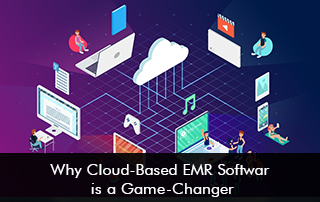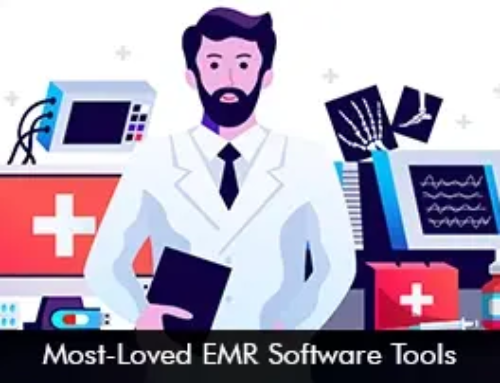Cloud-based EMR software, unlike traditional on-premise EMR, offers unparalleled flexibility, scalability, and accessibility. In this blog, we’ll explore why cloud-based EMR software is revolutionizing healthcare by covering:
-
Accessibility from Anywhere, Anytime
-
Cost-Effectiveness and Reduced IT Burden
-
Enhanced Security and Compliance
-
Seamless Updates and Scalability
-
Improved Collaboration and Interoperability
-
Disaster Recovery and Data Backup
-
Support for Telemedicine and Remote Care
Let’s dive into why cloud-based EMRs are the future of healthcare technology.
1. Access EMR Software from Anywhere, Anytime
One of the biggest advantages of cloud-based EMR software is the ability to access patient records securely from any location with an internet connection.
Key Benefits:
-
Remote Access: Physicians can review patient charts, update records, and prescribe medications from home, on the go, or while at satellite clinics.
-
Multi-Device Compatibility: Works on desktops, laptops, tablets, and smartphones, ensuring flexibility for healthcare providers.
-
Telehealth Integration: Supports virtual consultations by allowing doctors to pull up records during video visits.
This level of accessibility is especially valuable in emergencies, rural healthcare settings, or multi-location practices.
2. Cost-Effective EMR Software and Reduced IT Burden
Traditional on-premise EMR systems require significant upfront investments in servers, IT infrastructure, and maintenance. Cloud-based EMRs eliminate these costs with a subscription-based model.
How It Saves Money:
-
No Hardware Costs: No need for expensive servers or data centers.
-
Lower Maintenance Fees: The vendor handles software updates, security patches, and troubleshooting.
-
Predictable Monthly Pricing: Pay-as-you-go models help clinics budget effectively without unexpected IT expenses.
Small and mid-sized practices benefit the most, as they can access enterprise-level EMR capabilities without a massive capital investment.
3. Enhanced Data Security and Compliance
Data security is a top concern in healthcare, and cloud-based EMRs often provide better protection than on-premise systems.
Security Advantages:
-
Enterprise-Grade Encryption: Protects patient data both in transit and at rest.
-
Automatic Compliance Updates: Ensures adherence to HIPAA, GDPR, and other regulations.
-
Advanced Access Controls: Role-based permissions prevent unauthorized access.
Reputable cloud EMR providers invest heavily in cybersecurity, offering features like multi-factor authentication (MFA), audit logs, and regular penetration testing—measures that many small practices couldn’t afford independently.
4. Seamless EMR Software Updates and Scalability
With traditional EMRs, updates require manual installation and downtime. Cloud-based systems, however, roll out improvements automatically.
Why This Matters:
-
Always Up-to-Date: No need to install patches—new features and security fixes deploy instantly.
-
Scalable Storage: Easily expand data storage as the practice grows without buying additional servers.
-
Customizable Workflows: Adapt the EMR to changing practice needs without costly reconfigurations.
This ensures that healthcare providers always have the latest tools without disruptions.
5. Improved Collaboration and Interoperability
Healthcare is a team effort, and cloud-based EMRs break down silos by enabling real-time collaboration.
Key Features:
-
Instant Data Sharing: Specialists, labs, and pharmacies access records without delays.
-
Interoperability Standards: Supports FHIR, HL7, and APIs for smooth integration with other systems.
-
Care Coordination Tools: Secure messaging, referral tracking, and shared patient dashboards improve teamwork.
This leads to faster diagnoses, fewer duplicate tests, and better-coordinated care.
6. EMR Software Disaster Recovery and Data Backup
Natural disasters, cyberattacks, or hardware failures can cripple a practice relying on local servers. Cloud-based EMRs provide built-in disaster recovery.
How It Protects Data:
-
Automatic Backups: Patient records are continuously saved in secure, geographically dispersed data centers.
-
Quick Recovery: If a system fails, data can be restored in minutes, not days.
-
Business Continuity: Clinics can keep operating even if their physical location is compromised.
This level of reliability is critical for maintaining patient care during unforeseen events.
7. Support for Telemedicine and Remote Care
The rise of telehealth has made cloud-based EMRs indispensable.
Telehealth Integration Benefits:
-
Virtual Visits: Doctors can access EMRs during video consultations for informed decision-making.
-
Remote Monitoring: Syncs with wearable devices and IoT health tools for chronic disease management.
-
Patient Portals: Enables secure messaging, online appointment booking, and prescription refills.
As telemedicine becomes standard, cloud EMRs ensure practices stay ahead of the curve.
The Future of Healthcare Is Cloud-Based EMR Software
Cloud-based EMR software is transforming healthcare by offering greater accessibility, cost savings, security, and scalability compared to traditional systems. From small clinics to large hospital networks, the benefits are undeniable:
✅ Access records anytime, anywhere
✅ Cut costs on IT infrastructure
✅ Stay compliant with top-tier security
✅ Scale effortlessly as your practice grows
✅ Enhance care coordination and telehealth
The shift to cloud-based EMRs isn’t just a trend—it’s the future of efficient, patient-centered care.
Is your practice still using an outdated EMR software? Transitioning to a cloud-based solution could be the upgrade you need to streamline operations and improve patient outcomes.








